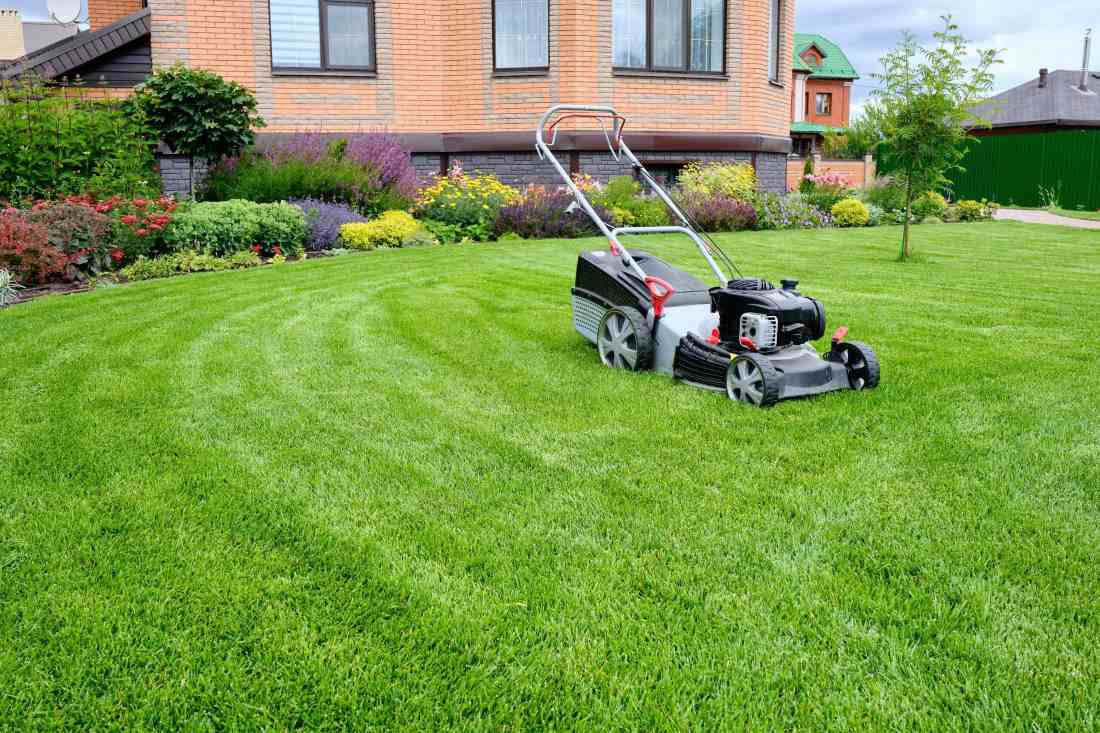
Lawn Care Made Easy: Answers to 9 FAQs About Mowing
Jamie TedderMowing is one of the easiest and most rewarding lawn care tasks—you see the results immediately. A freshly mowed lawn looks neat, green, and inviting. But skipping mowing? The signs are just as apparent. Overgrown grass quickly makes a lawn look untidy, uneven, and harder to manage.
That’s why timing is so important, especially if you’ve recently laid sod. Mow too early, and you risk dislodging the sod before it has rooted properly. Wait too long, and you may end up with an overgrown lawn, making it harder to cut evenly and affecting root development. Once the sod is established, regular mowing encourages dense, lateral growth, creating a healthy, thick lawn that resists weeds.
9 FAQs About Lawn Mowing
Understanding when and how to mow makes all the difference in lawn care. But how often should you mow? When’s the best time to do it? What if it’s been raining for days? Below, we tackle the most common questions about mowing to help you get the best results for your lawn.

1. When should you start cutting grass in the spring?
The first mow of the season sets the tone for healthy growth. Once your grass starts growing again after winter dormancy, it's time to mow. Ideally, this should be done before the weather warms up. Keep the mower blades high for the first cut—just trim the tops of the grass blades. This encourages the grass to thicken, helping to crowd out weeds and moss.
In Florida, warm-season grasses like Bermuda, Zoysia, and St. Augustine don’t always go fully dormant. Instead of waiting for spring, mow whenever your grass reaches its recommended height—about 1-2 inches for bermudagrass and zoysiagrass and 2.5-4 inches for St. Augustine—to keep it healthy year-round.
2. When should you mow new sod for the first time?
If you've recently laid sod, hold off on mowing until it has rooted firmly into the soil. This usually takes two to four weeks. Cutting too early can stress the grass and disrupt root development.
For the first mow, make sure the sod is dry to avoid pulling up loose sections. Set your mower blade higher than usual to avoid cutting too much at once. Use a sharp mower blade for a clean cut that reduces stress on the young grass.
3. How often should you mow your lawn?
Mowing frequency depends on grass type, weather, and soil conditions. Some grasses, like bermudagrass, grow vigorously and require frequent mowing, while zoysiagrass grows slower and needs less cutting.
Follow the one-third rule—never remove more than one-third of the grass height in a single mow. Cutting too much at once weakens the grass, making it prone to stress and scalping. Frequent mowing also encourages lateral growth, resulting in a thicker, greener lawn.
4. Does it matter when you mow your lawn?
Yes! Timing affects the quality of the cut and the overall health of your grass. The best times to mow are mid-morning (8-10 AM), when the dew has dried, and the sun isn’t too intense, or late afternoon (4-6 PM), when the heat has subsided, giving the grass time to recover before nightfall.
Avoid mowing early in the morning, as wet grass can tear instead of cutting cleanly, increasing the risk of disease. Midday mowing should also be avoided because the intense sun can stress freshly cut grass. Late evening is not ideal either—after mowing, grass produces sap to heal, but without sunlight, it remains vulnerable to fungal infections overnight.
5. Should you mow before fertilizing?
Yes! Mowing before fertilizing helps nutrients reach the soil more efficiently, ensuring your lawn gets the maximum benefits. A freshly cut lawn allows fertilizer to be evenly distributed, preventing clumps from sitting on top of tall grass blades.
When grass is too long, fertilizers can get trapped in the foliage instead of reaching the soil, leading to uneven absorption and potential waste. Mowing beforehand also clears away debris, making it easier for water to carry the nutrients down to the roots. However, avoid mowing too short, which can stress the grass and make it more susceptible to burning or nutrient runoff.
6. What happens if you never mow?
If you let grass grow too long, it can quickly become overgrown and difficult to manage. Tall grass can:
-
Shade itself, resulting in weak, thin growth underneath.
-
Create an ideal environment for weeds and pests.
-
Become harder to mow, requiring multiple cuts to bring it back to a manageable height.
Regular mowing keeps your lawn healthy, prevents weed invasions, and promotes thick, even growth.
7. Is it better to cut grass before or after rain?
Before rain is ideal—dry grass cuts cleaner and prevents clumping. However, if your lawn is overdue for a mow and rain is in the forecast, it’s okay to mow beforehand to avoid excessive overgrowth.
Mowing before rain is ideal—dry grass cuts more cleanly and prevents clumping, which can leave behind messy clumps that block sunlight and promote disease. However, if your lawn is overdue for a mow and rain is in the forecast, it’s better to cut it beforehand rather than letting it grow too long. Overgrown grass can become more difficult to manage after heavy rain, leading to an uneven cut and increased stress on your lawn.
8. What happens if you mow your lawn when it’s wet?
Mowing wet grass isn’t ideal, but sometimes it’s necessary—especially during rainy seasons. Here’s what to keep in mind:
-
Wet clippings can clump together, creating uneven patches.
-
The mower wheels can compact wet soil, making it harder for grass to grow.
-
Wet grass is harder to cut cleanly, leading to jagged edges that increase disease risk.
However, if waiting means your grass will become overgrown, it's better to mow carefully in damp conditions rather than skip it entirely. Use a sharp blade, mow slowly, and bag the clippings to prevent buildup.
9. Is it better to mow fast or slow?
A steady, controlled pace is best for achieving a clean, even cut. Mowing too fast can lead to uneven patches, missed spots, and torn grass blades, which stress the lawn and increase the risk of disease. It also raises the chance of scalping—cutting too low and damaging the grass. To get the best results, adjust your speed based on your lawn’s condition, take your time, and always keep your mower blades sharp for a precise, healthy cut.

Best Practices for Mowing Your Lawn in Spring
Proper mowing techniques go beyond just keeping your lawn neat—they contribute to its overall health and resilience. A well-maintained mowing routine can improve growth, reduce stress, and increase your lawn’s resistance to heat, drought, and foot traffic. By following a few best practices, you can keep your grass lush, green, and thriving throughout the season.
-
Sharpen your mower blades before the season starts to ensure clean cuts, as dull blades can tear the grass, leaving it vulnerable to disease and discoloration.
-
Adjust your mowing height based on the grass type—cut higher in summer to retain moisture and protect against heat stress, while lowering it slightly in spring encourages fresh, vigorous growth.
-
Mulch your grass clippings instead of bagging them, as they break down quickly, returning essential nutrients to the soil and reducing the need for additional fertilizer.
-
Change mowing patterns regularly to prevent soil compaction and ruts, which can lead to weak growth and an uneven lawn over time.
The Role of Sod in a Healthy Lawn
One of the easiest ways to achieve a healthy, uniform lawn is by starting with sod. Sod is mature grass that has been professionally cultivated and harvested in rolls or slabs. Its maturity allows it to establish new roots quickly once installed, creating a dense, thriving lawn in a short period. Unlike seeding, which requires patience and careful maintenance, sod provides instant coverage and erosion control, making it an excellent choice for homeowners looking for immediate results.
-
Instant results—no waiting for seeds to sprout.
-
Thick, even coverage—reducing weed growth.
-
Faster establishment—strong root development in weeks.
For homeowners in Florida, Bethel Farms is a trusted provider of grass sod for sale, offering high-quality sod suited for warm climates. Whether you’re repairing patches or starting fresh, sod is a great way to simplify lawn care while achieving a lush, green yard.

Final Thoughts
Mowing is one of the most rewarding lawn care tasks—it provides immediate results while promoting long-term grass health. By mowing at the right time, following best practices, and using high-quality sod, you can maintain a lush, thriving lawn year-round.
Have more questions about mowing or sod? Let us know in the comments!

